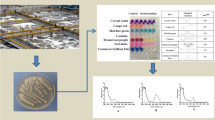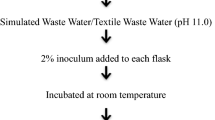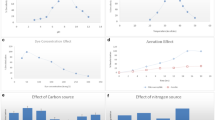Abstract
Synthetic dyes are released into the environment from textile industrial effluents. The discharge of this colored wastewater into rivers and lakes leads to a reduction in sunlight penetration in natural water bodies, which, in turn, decreases both photosynthetic activity and dissolved oxygen concentration and is toxic to living beings. Bacterial isolates are optimized for growth and biomass production before using them for decolorizing dye effluent. The bacterial isolates Bacillus sp. 1 and Bacillus sp. 2 were employed at different percentages by volume with standard nutrient concentration. Of these bacterial isolates Bacillus sp. 2 recorded maximum color reduction. The pH and electrical conductivity (EC) were reduced in the decolorized effluent, and a reduction in biologic oxygen demand, chemical oxygen demand, total suspended solids, and total dissolved solids (TDS) were also observed.
Similar content being viewed by others
References
Zollinger, H. (1987), in Color Chemistry—Synthesis, Properties and Applications of Organic Dyes and Pigments, VCH, New York, pp. 92–100.
Pierce J. (1994), J. Soc. Dyers Colorists 110, 131–134.
Nigam, P., Banat, I. M., Singh, D., and Marchant, R. (1996), Process Biochem. 31, 435–442.
Yatome, C., Ogawa, T., Hayashi, H., and Ogawa, T., (1991) Environ. Sci. Health A 26, 471–485.
Zhou, W., and Zimmermann, W. (1993), FEMS Microbiol. Lett. 107, 157–162.
Pandey, A., Nigam, P., Soccol, C.R., Soccol, V. T., Singh, D., and Mohan, R. K. (2000), Biotechnol. Appl. Biochem. 31, 135–152.
Dorinadince, L., Fureoane, S., Vamanu, E., Mirela burcea H and Campeanu (2001), Roum Biotechnol. Lett. 6, 111–118.
Ogawa, T., Yatome, C., Idaka, E., and Kamiya, H. (1986), J. Soc. Dyers Colorists 2, 12–14.
Wuhrmann, K., Mechsher, K., and Kappeler, T. (1980), Eur. J. Appl. Microbiol. Biotechnol. 9, 325–338.
Verma, S. R., Tyagi, A. K., and Daleta, R. C. (1974), Indian J. Environ. Health 19, 165–175.
Mou, O. G., Lim, K. K., and Shen, H. P. (1991), Biotechnol. Adv. 9, 613–622.
Murali, S., Narayan, A., Vidyavati, E., and Sriniketan, G. (2000) J. Indian Pollut. Control 16, 211–215.
Yatome, C., Ogawa, T., Hishida, H., and Tagochi, T. (1990) J. Soc. Dyers Colorists 106, 280–282.
Hu, T. L. (1994), Bioresour. Technol. 49, 47–51.
Waksman, S. A. and Fred, B. (1922), Soil Sci. 14, 27–28.
Seelay, J. and Vandemark, A. J. (1994), J. Bacteriology 176, 656–664.
Clowes, R. C. and Hayes, W. (1968), Experiments in Microbial Genetics, Blackwell, Edinburgh, UK.
Author information
Authors and Affiliations
Corresponding author
Rights and permissions
About this article
Cite this article
Sukumar, M., Sivasamy, A. & Swaminathan, G. Decolorization of textile dye effluent by genetically improved bacterial strains. Appl Biochem Biotechnol 136, 53–62 (2007). https://doi.org/10.1007/BF02685938
Received:
Revised:
Accepted:
Issue Date:
DOI: https://doi.org/10.1007/BF02685938




